LA CRITICA
Piero Garibaldi
Curatore eventi d’arte – Art Event CuratorComunicato stampa per la personale alla Galleria Lazzaro
Forte dei Marmi 1-15 Agosto 2017
La Fluid Art, interpretata da Paola Colleoni, esordisce a Forte dei Marmi per accendere i riflettori sul palcoscenico dell’arte contemporanea in programma nel mese di Agosto (2017) in Versilia.
L’Associazione Culturale Lazzaro, di Via Pascoli 8/A, sarà il contesto in cui l’artista bergamasca esibirà in anteprima la serie che, sviluppo di una tecnica, fornisce un’ottica propedeutica sul percorso realizzativo della pittrice.
La mostra dal titolo “Il Segno dell’Onda”, “Sea Shore”, a cura di Piero Garibaldi, (…) per l’evento inaugurale prevede gli interventi di Gino Franchi, Presidente della Sez. di Lucca dell’ Associazione Nazionale fra Mutilati ed Invalidi di Guerra e Fondazione, e dell’ Avvocato Alberto Russo, in qualità di Presidente della Round Table 53 Carrara Val di Magra, che attraverso gli enti di riferimento hanno promosso, con il Museo Ugo Guidi, l’Associazione Amici del Museo Ugo Guidi, e l’Ass.ne Culturale Archivio Grazia Leoncini, la comunicazione dell’iniziativa.
Paola Colleoni, osserva Garibaldi, attiva un riguardo nella verifica di un lato creativo nell’ambito del quale l’acrilico viene disteso con versatilità in un processo segnale di ostilità nei confronti della dimensione. L’esternazione stilistica è proposta, dal tema, attraverso un’assonanza con l’interrotto moto dell’onda che nella continuità lavora la propria sembianza. L’attitudine alla mutazione è un aspetto artistico, di cui le produzioni inerenti la Fluid Art sono oggetto, per una successione che approfondisce il segno ed il colore del profilo artistico di Paola Colleoni che, nel contesto, trova un progresso e non una casuale distrazione in termini di sperimentale intraprendenza.
Gli insegnamenti appresi a Bottega, e gli studi nei corsi di disegno e pittura dell’ Accademia Carrara di Bergamo, hanno condotto all’attuale apertura lavorativa (…).
Press Release for the Solo Exhibition at Galleria Lazzaro
Forte dei Marmi, August 1-15, 2017
Fluid Art, as interpreted by Paola Colleoni, makes its debut in Forte dei Marmi, shining a spotlight on the contemporary art stage during the August (2017) events in Versilia. The Lazzaro Cultural Association, located at Via Pascoli 8/A, will be the venue where the Bergamo-based artist will showcase her latest series. This series, a development of a specific technique, offers an introductory perspective on the artist’s creative journey.
The exhibition, titled “Il Segno dell’Onda” (Sea Shore), curated by Piero Garibaldi, will feature speeches during the inaugural event from Gino Franchi, President of the Lucca Section of the National Association for Mutilated and War Invalids and Foundation, and Attorney Alberto Russo, President of Round Table 53 Carrara Val di Magra. These entities, along with the Ugo Guidi Museum, the Friends of Ugo Guidi Museum Association, and the Grazia Leoncini Cultural Archive Association, have actively promoted the initiative.
According to Garibaldi, Paola Colleoni delves into a creative exploration in which acrylic is applied with versatility, reflecting a dynamic confrontation with the concept of space. Her stylistic expression aligns with the interrupted motion of a wave, which continuously reshapes itself. The tendency toward transformation is a key artistic trait, particularly evident in Fluid Art, as her works probe deeper into the interplay of line and color, shaping her artistic identity. In this context, her work signifies progress rather than a mere experimental distraction.
The teachings she absorbed in workshops, along with her studies in drawing and painting at the Accademia Carrara in Bergamo, have led to her current artistic evolution (…).
Emanuela Mazzotti
Critico d’arte – Art CriticMondi delle meraviglie
di Emanuela Mazzotti
Critico d’arte
La favola di Alice nel paese delle meraviglie, si qualifica come una storia “allucinata”, uno dei testi più spietati che la letteratura vittoriana abbia prodotto, ed in effetti questa non è una favola per ragazzi. La storia, a tutti nota, racconta di una fanciulla che intraprende un percorso che rappresenterà la messa in discussione della sua identità.
Il sogno di Alice inizia nel momento in cui lei si è addormentata e vede il Coniglio Bianco correre velocemente verso la tana. Da questo punto inizia il cammino in un mondo fantastico, un abisso onirico che rappresenta il punto d’incontro tra realtà e sogno. In questo mondo le regole convenzionali risultano rovesciate, tanto che Carroll afferma: ” Life, what is but a dream?” In questo modo l’autore conferma la relazione inversa tra le regole che governano la nostra esistenza consapevole e quella che viviamo attraverso il sogno, diverse, perché nel sogno prevale la dimensione psichica o l’inconscio. Da queste considerazioni emerge che la condizione degli individui è priva di ogni logica di senso e la ricerca di un senso diviene l’obiettivo inane dell’uomo.
Dal sogno all’immaginario
Paola Colleoni ha intrapreso nella sua pittura, dopo difficili esperienze personali, un cammino analogo a quello di Alice, ma all’opposto della protagonista della storia di Carroll, l’artista è ben consapevole di quale sia il significato del sogno, quel sogno che inevitabilmente ha punti di contatto con la sua storia. Il percorso inizia dalla percezione della realtà, percezione e non visione, non a caso, dato che la sua pittura va oltre la semplice osservazione del vero, perché nasce nella psiche. “Il reale rimarrà sempre inconoscibile”, con queste parole Sigmund Freud, nel Compendio, afferma che l’uomo può conoscere solo le qualità esposte sulla superficie, le proprietà di continua trasformazione ed evoluzione che gli appartengono, riflettendosi su di lui come fenomeni, nell’impossibilità di cogliere l’essenza di quello che abbiamo di fronte, la realtà che stiamo vivendo, assumendo la sua esistenza come dato a priori. La percezione nasce nella mente e non nel senso della vista, tale che le informazioni che assimiliamo sono qualche cosa che è colto nel suo formarsi, costruito dall’interno e dipendente esclusivamente dal soggetto. L’artista posa il suo sguardo sulle cose ma quelle cose si caricano via via di nuovi significati, costruiti sul piano simbolico e mai nella dimensione del racconto. Sono luccichii, sfavillare di luci nei contrasti chiaroscurali, lento formarsi dell’immagine nel ricordo. I paesaggi si declinano per colori di ampie campiture, a volte decisamente contrastati che esaltano quel quid assolutamente onirico che l’arte trattiene come traccia dell’esistere. Come nei sogni le regole consolidate possono anche essere disattese, il vero diventa artificio, pura architettura d’invenzione.
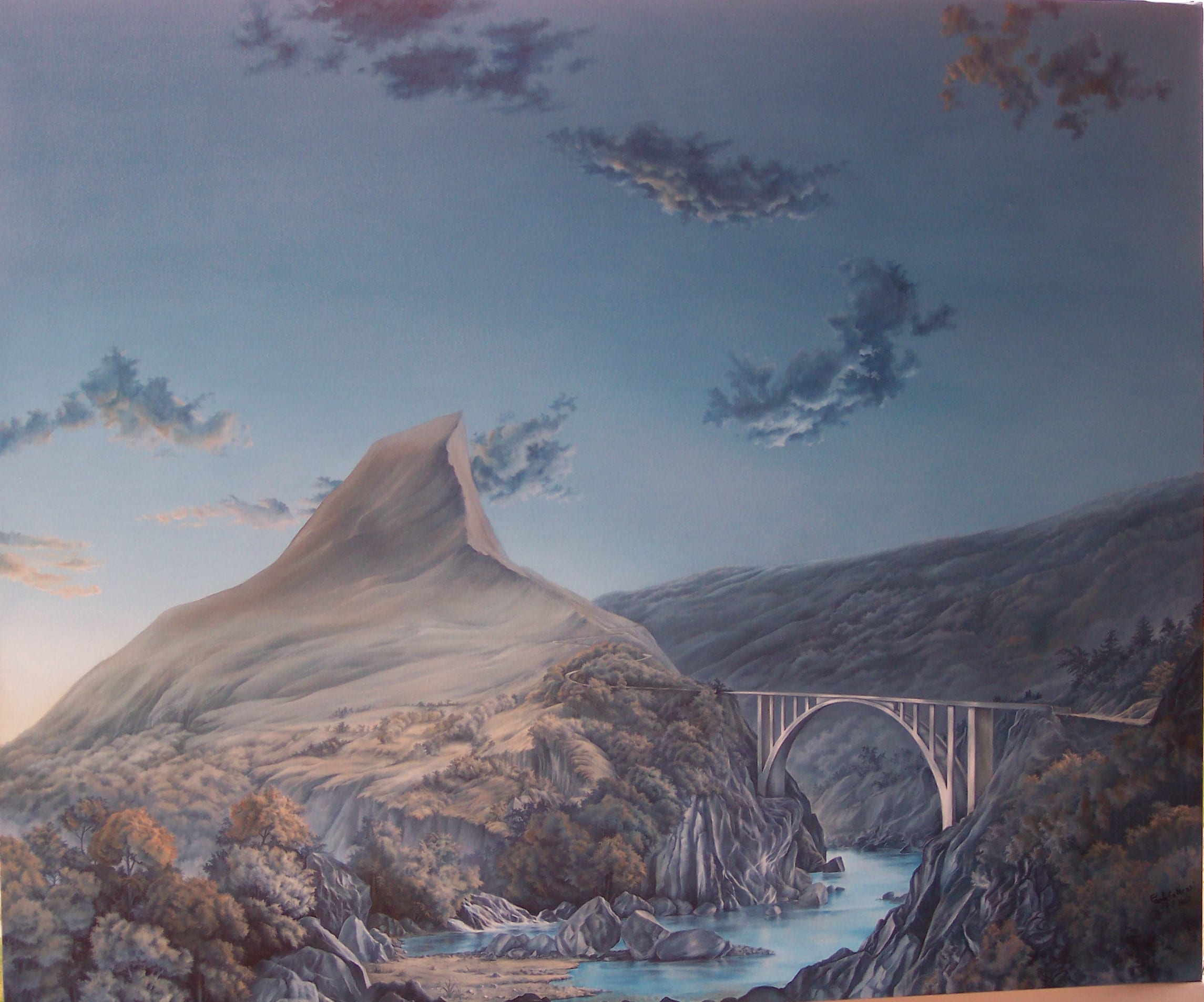
A questo proposito si veda: “Luce imprigionata – Le pont de Ponsonnas“, dove il soggetto si declina attraverso un paesaggio nel quale spicca un’architettura “impossibile”, gettata attraverso due crinali montuosi sul fiume che scorre più in basso. Il paesaggio è uno dei luoghi in cui si specchia l’animo dell’artista che in questo parziale disvelamento di sé, suggerisce come tutto ciò che vorrebbe rimanere nascosto, segreto, sia affiorato come risultato perturbante. ” Dream, what is but life”? Potremmo così invertire i termini della questione, comprendere quale sia il confine tra inconscio ed esperienza esistenziale: vita e sogno ne determinano le oscillazioni estreme, ovvero che cosa appartiene all’onirico? Che cosa appartiene all’esperienza del vero? Queste montagne, il colore del cielo, i boschi, il fiume possono essere in verità solo una proiezione della coscienza, oppure la percezione per immagini della propria esistenza che si dipana in modo non lineare nel tempo, come in “Mattino al Forte – La via degli alberi, la via del tempo“.
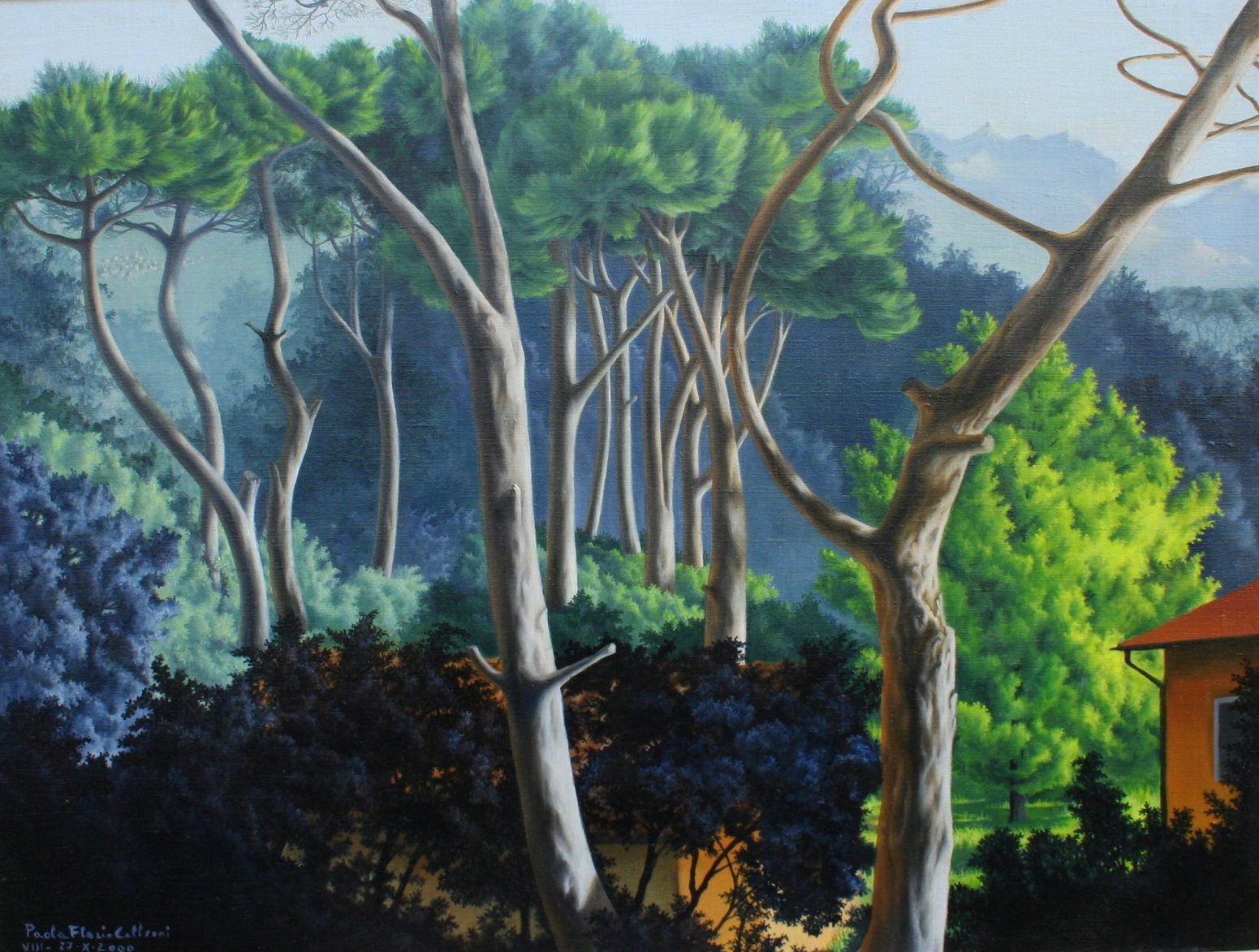
La casa del tempo

Lo stesso corso d’acqua, tema ricorrente nella pittura di Paola Colleoni, rimanda al lento fluire del tempo, anche se talvolta la corrente sembra più andare a ritroso piuttosto che progredire verso il mare. Così in: “Presentimento improvviso – Lugano vento dell’Est” le acque sembrano ferme nel gorgo, mentre nubi minacciose si accumulano tra i monti. La pace e la serenità del luogo è azzerata dall’incombere minaccioso della tempesta, allucinata premonizione, con un’intensità senza eguali, della forza dirompente di quel che dal di fuori ci viene incontro, ci assedia, nella consapevolezza che il tempo non ricalca alcuna struttura logica o rassicurante. Mi sembra che quest’ultimo aspetto si ricolleghi ad una visione tutta contemporanea, per il turbamento che coglie lo spirito e in qualche modo lo avviluppa; concezione questa che, come le acque del fiume, rallenta, gorgoglia, scorre in modo tutt’altro che tranquillo identificandosi con “l’abitare dell’uomo sulla terra”. Passato, presente e futuro sono categorie che hanno alterato il loro logico ordine. La casa dell’uomo è rivelata nello spaesamento, in uno scorrere altro e contraddetto, nell’eterno fluttuare dei gorghi.
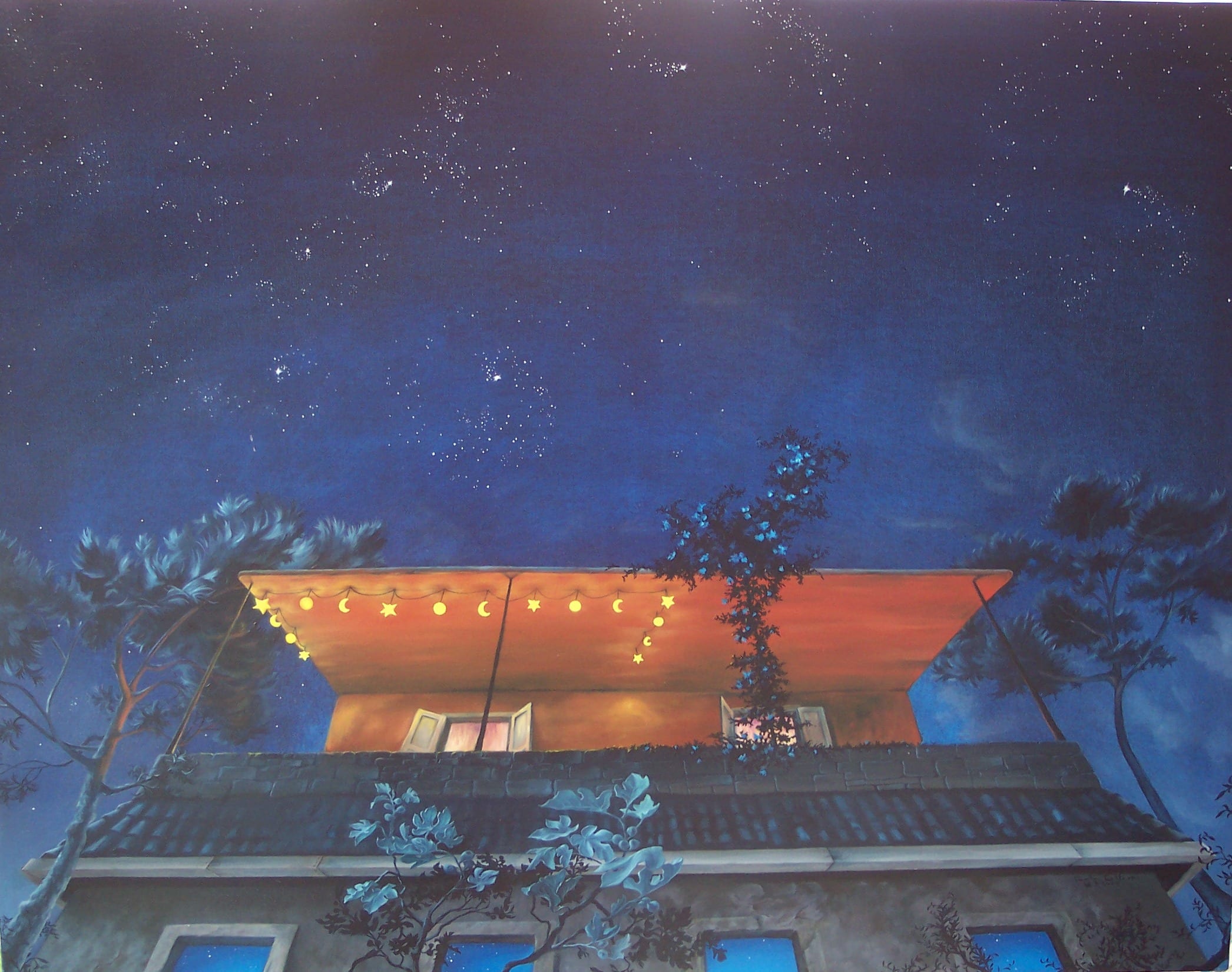
La casa è dove risiede il sogno, la coscienza “espressa”, proiettata dentro noi stessi. “La mia terrazza fra passato e futuro” interroga queste ragioni del tempo. La casa è stata luogo dell’incubo, tracce, segni di un tormentato esistere sono ancora visibili come impercettibili scalfitture sulla sua facciata, ma le finestre aperte sembrano suggerire un’ipotesi di futuro, certo la vista “da sotto in su” cambia il piano prospettico in una forzata veduta verticale, tale che la casa sembra alzarsi verso le stelle, su verso il cielo che rimanda un luminoso riverbero notturno. E’ proprio quel “fondo blu” che permette alle stelle di brillare e riverberare la loro luce sulla terra, così che noi si possa percepire quella luce, in una aspettativa di senso resa possibile proprio da quel mistero che è sguardo dell’Universo. In questi passaggi si identificano le influenze dell’arte moderna e contemporanea accanto alle suggestioni che l’immagine cinematografica ha sicuramente esercitato, specialmente per quanto concerne diverse pellicole della seconda metà del Novecento. .
Sul piano operativo l’artista si è formata attraverso un lungo apprendistato che le ha consegnato una sicura abilità esecutiva; la tecnica inizia infatti nel disegno che, sin dalle prime esperienze, ha costituito l’aspetto ideativo della sua arte. A riprova di ciò, Paola si muove con felice espressione tra la pittura, le tecniche miste, la smaltatura, rievocando nel passaggio da un linguaggio all’altro, proprio quel divenire, quella trasformazione che riguarda non solo la condizione umana, ma più in generale la materia. La questione della tecnica ha radici molto antiche, nella tradizione Manierista, per esempio, si può riscontrare come l’arte sia concepita nel suo “farsi”, costituendosi anche attraverso l’uso disincantato del mezzo espressivo, determinandosi come categoria autonoma rispetto altri saperi, capace di stabilire un proprio statuto. Il lavoro di Paola Colleoni non è sicuramente estraneo ad un’arte che richiede una riflessione sull’utilizzo del mezzo espressivo, non come esito dell’operazione artistica, quanto piuttosto come voce amplificata dell’Io. Come gli antichi maestri concepisce la sua come una continua ricerca che non si esaurisce nel risultato come “piacevole” epilogo dell’operazione artistica, quanto come indagine nel significato del gesto estetico.
Il “bello” come categoria artistica non ha senso nel nostro tempo, quindi la risoluzione possibile agli interrogativi resta sempre quella che gli artisti si sono posti in tempi non certo recenti. La domanda è: a che cosa serve l’arte ed è possibile una ricerca di senso attraverso l’ estetica? La risposta risiede nel riconoscere dell’arte la vocazione intellettuale, determinarla come “fatto” mentale, superando l’antica e annosa questione della mimesis, nel riconsegnarla ad una concezione del mondo esistenzialista. L’impronta esistenzialista è così pervasiva nella cultura e nell’arte del Novecento che ha finito per caratterizzare molti percorsi trasversali del sapere. Questa percorso ha riconosciuto e accettato la debolezza e la fragilità dell’essere umano elevandole a valore distintivo della qualità umana. Quei tormenti, quelle allucinazioni che sono prerogativa dell’arte del nostro tempo sono in fondo lo specchio delle nostre coscienze, riconoscimento di un comune sentire, patrimonio dell’essere.
Worlds of Wonders
by Emanuela Mazzotti
Art Critic
Alice’s Tale in Wonderland is classified as a “hallucinated” story, one of the most ruthless texts produced by Victorian literature, and indeed it is not a fairy tale for children. The story, well known to all, tells of a young girl who embarks on a journey that will challenge her identity.
Alice’s dream begins when she falls asleep and sees the White Rabbit running swiftly towards the burrow. From this point, she embarks on a journey through a fantastic world, a dreamlike abyss that represents the intersection between reality and dream. In this world, conventional rules are overturned, so much so that Carroll states: “Life, what is but a dream?” In this way, the author confirms the inverse relationship between the rules governing our conscious existence and those we live through dreams, which are different because in dreams the psychic dimension or the unconscious prevails. From these considerations, it emerges that the human condition is devoid of any logical sense, and the search for meaning becomes man’s futile pursuit.
From Dream to Imagination
Paola Colleoni, in her painting, after difficult personal experiences, has undertaken a path similar to Alice’s, but unlike the protagonist of Carroll’s story, the artist is well aware of the meaning of the dream, a dream that inevitably has points of contact with her own story. The journey begins with the perception of reality, perception rather than vision, which is not accidental, as her painting goes beyond mere observation of reality, as it is born from the psyche. “Reality will always remain unknowable,” as Sigmund Freud stated in his *Compendium*, affirming that man can only know the qualities exposed on the surface, the constantly transforming and evolving properties that belong to it, reflecting back on him as phenomena, in the impossibility of grasping the essence of what we face, the reality we are living, assuming its existence as a given. Perception arises in the mind and not through the sense of sight, so that the information we assimilate is something grasped in its formation, constructed from within and dependent solely on the subject. The artist casts her gaze on things, but those things gradually take on new meanings, constructed on a symbolic plane and never in the dimension of narrative. They are flashes, shimmering lights in chiaroscuro contrasts, the slow formation of an image in memory. The landscapes unfold in large fields of color, sometimes strongly contrasted, enhancing that utterly dreamlike quality that art retains as a trace of existence. As in dreams, established rules can also be ignored, and truth becomes artifice, pure invention architecture.

In this regard, see: “Imprisoned Light – The Pont de Ponsonnas“, where the subject unfolds through a landscape in which an “impossible” architecture stands out, cast across two mountain ridges over the river flowing below. The landscape is one of the places where the artist’s soul is mirrored, suggesting in this partial revelation how everything that wished to remain hidden, secret, has surfaced as a disturbing result. “Dream, what is but life?” We could thus reverse the terms of the question, understanding what is the boundary between the unconscious and existential experience: life and dream determine its extreme oscillations. What belongs to the dream? What belongs to the experience of truth? These mountains, the color of the sky, the woods, the river may in fact only be a projection of the consciousness, or the perception through images of one’s existence, unfolding non-linearly in time, as in “Morning at the Fort – The Way of Trees, the Way of Time.”

The House of Time

The same body of water, a recurring theme in Paola Colleoni’s painting, evokes the slow flow of time, even though sometimes the current seems to flow backward rather than progress toward the sea. Thus, in: “Sudden Premonition – Lugano East Wind“, the waters seem still in the whirlpool, while menacing clouds accumulate between the mountains. The peace and serenity of the place are nullified by the threatening approach of the storm, a hallucinatory premonition, with an intensity unmatched, of the overwhelming force of what comes from the outside, besieging us, with the awareness that time follows no logical or reassuring structure. This last aspect seems to relate to a thoroughly contemporary vision, for the turmoil that grips the spirit and in some way envelops it; a conception that, like the waters of the river, slows, swirls, flows in a decidedly turbulent way, identifying with “man’s dwelling on earth.” Past, present, and future are categories that have altered their logical order. Man’s house is revealed in disorientation, in another, contradictory flow, in the eternal swirling of whirlpools.

The house is where the dream resides, the “expressed” consciousness projected within ourselves. “My Terrace Between Past and Future” questions these reasons for time. The house has been a place of nightmare; traces and signs of a tormented existence are still visible as imperceptible scratches on its facade, but the open windows seem to suggest a glimpse of the future. Certainly, the “upward” view changes the perspective into a forced vertical view, so much so that the house seems to rise towards the stars, upwards towards the sky, which reflects a bright nocturnal glow. It is precisely that “blue background” that allows the stars to shine and reflect their light on the earth, so that we can perceive that light, in an expectation of meaning made possible precisely by that mystery that is the gaze of the Universe. In these passages, one can identify the influences of modern and contemporary art alongside the suggestions that the cinematic image has undoubtedly exerted, especially regarding various films of the second half of the 20th century.
On a practical level, the artist was trained through a long apprenticeship that gave her a solid technical skill; the technique, in fact, begins with drawing, which, since her early experiences, has been the creative aspect of her art. Proof of this, Paola moves with joyful expression between painting, mixed techniques, and enameling, evoking in the transition from one language to another precisely that becoming, that transformation that concerns not only the human condition but more generally matter itself. The issue of technique has very ancient roots. In the Mannerist tradition, for example, one can see how art is conceived in its “making,” also constituting itself through the disenchanted use of the expressive medium, determining itself as an autonomous category, distinct from other knowledge, capable of establishing its own status. Paola Colleoni’s work is certainly not alien to an art that requires reflection on the use of the expressive medium, not as the outcome of the artistic operation but rather as an amplified voice of the self. Like the ancient masters, she conceives her art as a continuous search that does not end in the result as a “pleasing” conclusion of the artistic operation but as an inquiry into the meaning of the aesthetic gesture.
The “beautiful” as an artistic category makes no sense in our time, so the possible resolution to the questions remains what artists have been asking themselves for quite some time. The question is: what is the purpose of art, and is it possible to search for meaning through aesthetics? The answer lies in recognizing the intellectual vocation of art, determining it as a “mental” act, overcoming the ancient and thorny issue of mimesis, and returning it to an existentialist conception of the world. The existentialist imprint is so pervasive in 20th-century culture and art that it has
Angela Rizzo
ScrittriceDalla pubblicazione “L’ Opinione” (Anno XI n. 21 15-09-2009)
Paola Colleoni, la quale vive ed opera a Bergamo, ha un grande interesse per la natura, che dipinge nei suoi vari aspetti. La pittrice evoca atmosfere oniriche al di fuori del tempo, creando ambienti ora densi ora rarefatti, che si propongono come terse superfici o abissali profondità oscure.

Il mondo nel suo apparire si snoda tra alterni e impervi passaggi, zone d’ombra e momenti di luce. La materia, creata dalla vibratile mano dell’artista, appare mobile e malleabile. L’avvicendamento di differenti intensità cromatiche e fasi luminose, il mutare di paesaggi, la metamorfosi continua e irreversibile della natura si configurano come una discesa nell’intimità dell’anima, della quale vengono riportate a galla le pulsioni più profonde. Fra tutte le arti, la pittura ha il potere di divenire una realtà autonoma che l’artista può praticare e nella quale può identificarsi, al di là della rappresentazione oggettiva. In tal senso, il colore non è più uno strumento, ma si qualifica come pura espressione di echi e memorie che affiorano spontaneamente su una superficie intrisa di suggestivo silenzio, in cui il presente non è altro che un futuro che diventa passato.
Il colore, protagonista di tutti i dipinti, allude continuamente a una dimensione spirituale elevata che si articola attraverso variegate sfumature: il bianchi tendono all’argento e squarciano con il loro alto timbro luminoso i toni più variegati degli sfondi, i verdi e i blu, di rara bellezza suggestiva, sono spesso ombreggiati da tinte cupe e inquietanti, simboli del senso misterioso dell’esistere. I colori istituiscono un campo che è insieme di trasparenza e di profondità, di sovrapposizioni e di luminescenze improvvise. Con maestria notevole, la Colleoni rende lo stato gassoso dell’aria, allude alla fase liquida e cangiante delle acque, talvolta torbide ma spesso densificate in distese glaciali, delinea macchie ombrose e solitarie, sulle quali e fra le quali filtra la speranza di luminosità magiche. E’ una sorta di visione cosmica quella che scorre davanti ai nostri occhi, che presenta passaggi repentini tra la massima luce e il massimo buio, in un incontro originale di toni caldi e freddi. La figura umana, laddove è rappresentata, contrasta, per la nitidezza ed il realismo dei particolari, con lo sfumato e rarefatto mondo che la circonda.
Su tutto sembra aleggiare un senso di misteriosa attesa non priva di fiducia e in particolare un’evocazione della grigia solitudine dell’uomo contemporaneo.
From the publication “L’Opinione” (Year XI n. 21, 15-09-2009)
Paola Colleoni, who lives and works in Bergamo, has a deep interest in nature, which she paints in its various aspects. The painter evokes dreamlike atmospheres outside of time, creating environments that are sometimes dense, sometimes rarefied, presenting as clear surfaces or dark, abyssal depths.

The world, in its appearance, unfolds through alternating and challenging passages, areas of shadow, and moments of light. The material, created by the artist’s vibrating hand, appears fluid and malleable. The succession of different chromatic intensities and phases of light, the changing landscapes, and the continuous and irreversible metamorphosis of nature are portrayed as a descent into the soul’s intimacy, from which the deepest impulses are brought to the surface. Among all the arts, painting has the power to become an autonomous reality that the artist can engage in and identify with, beyond objective representation. In this sense, color is no longer just a tool but becomes pure expression of echoes and memories that spontaneously emerge on a surface imbued with suggestive silence, where the present is nothing more than a future turning into the past.
Color, the protagonist of all the paintings, continually hints at an elevated spiritual dimension that unfolds through varied nuances: whites tend toward silver, breaking through with their high luminous tone, while the varied tones of the backgrounds—greens and blues of rare suggestive beauty—are often shaded by dark and unsettling tints, symbols of the mysterious essence of existence. The colors create a space that is both transparent and deep, layered with sudden luminescences. With remarkable skill, Colleoni captures the gaseous state of air, alludes to the liquid and changing phase of waters—sometimes murky but often solidified in icy expanses—and outlines shadowy, solitary patches through which the hope of magical brightness filters. A sort of cosmic vision unfolds before our eyes, presenting sudden transitions from maximum light to maximum darkness, in an original encounter of warm and cold tones. The human figure, where represented, contrasts with the blurred and rarefied world that surrounds it through the sharpness and realism of its details.
Overall, a sense of mysterious anticipation hovers over everything, not devoid of hope, and particularly an evocation of the gray solitude of contemporary humanity.
Carla Primiceri
Critico d’arte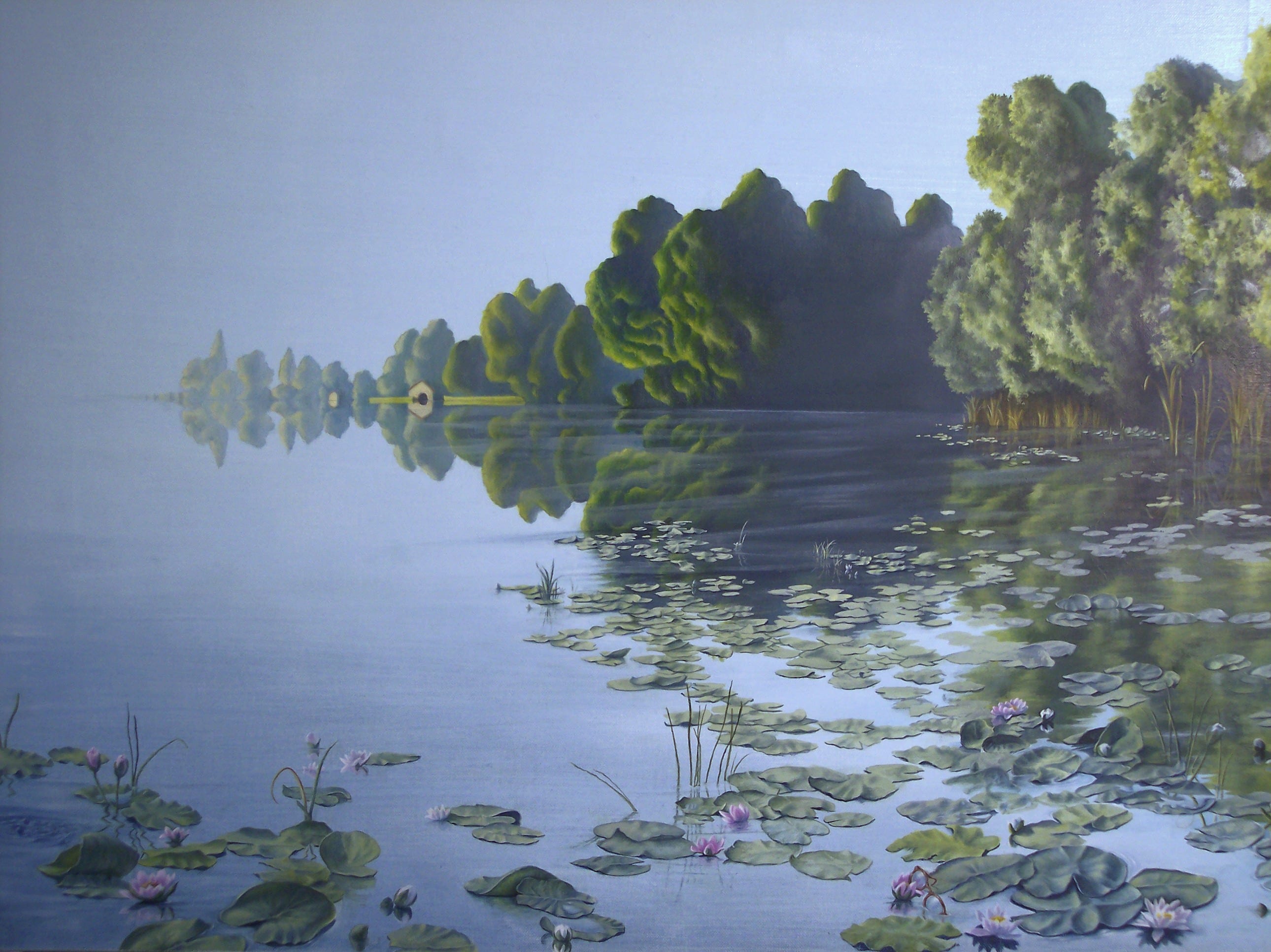
22 Dicembre 2009
Osservando con dedizione le opere di Paola Colleoni non possiamo far a meno di farci risucchiare da queste sospese atmosfere che solo nei sogni o nella poesia si possono trovare.

Rarefazioni immaginifiche, tramonti metafisici, rugiada e spessa foschia ibernate in colori docili, leggeri o sgargiantissimi e brillanti quando ci parla di verdi tondeggianti montagne come sculture d’un tempo lontano, risuonanti nelle nostre menti, che racchiudono un fiume calmo del quale non si vede né inizio né fine, ma dove ci si può immaginare come viandanti ancora capaci di stupirsi alla vista di un meraviglioso, misterioso fiordo e di una speciale luce aurea che riflette sulle acque e sulle nuvole.

Emanuela Mazzotti, critico d’arte, scrive:
“Che cosa appartiene all’esperienza del vero? Queste montagne, il colore del cielo, i boschi, il fiume …”.
Direi che nulla può appartenere all’esperienza del vero, né l’artista né l’arte, perché nel momento in cui il vero passa attraverso la mente umana, o alla mano di un artista, qualsiasi cosa che viene dal vero più non v’ appartiene. Ma se invece ne dovesse dare l’impressione, direbbe solo che quell’uomo è congelato e l’artista privo d’ispirazione e personalità, se non vi è trasformazione, anche nella ricerca della perfezione, scandagliando anche leggermente la “condizione” di vero o sconvolgendo almeno un po’ la contestualizzazione del vero … beh non ci sarebbe arte … io credo, né tanto meno impegno artistico.
Così come ci dice la stessa Paola , in una delle sue poesie scritta per l’opera “Itinerari – La Cisa”:
“… come strade percorrere emozioni e pensieri mentre la meta del viaggio scompare
E sempre riappare …”
Così è per chi crea, o meglio, rielabora filtrando con il proprio IO ciò che può essere fuori e dentro l’IO stesso.
Ma la dimensione del sogno è sospesa tra ciò che “è” e ciò che è “divenire”.
Un divenire schiacciato inesorabilmente dall’impossibilità verosimile dell’essere già.
Paola ci rivela una luce certa che segue presagi e risvegli:
“… Un risveglio, presagi. Poi, ci sarà luce …”

…E allora forse quel divenire tramite la luce, non a lungo attesa, potrebbe aver già traslato la dimensione sogno diventando poeticamente reale. Ma non Vera. “… Inesorabile il mio mondo tramonta, eppur pare fermo Sospeso nel tempo Ancora per poco si oppone alla prepotente luce Che vien da lontano e nasce con lancinante dolore”
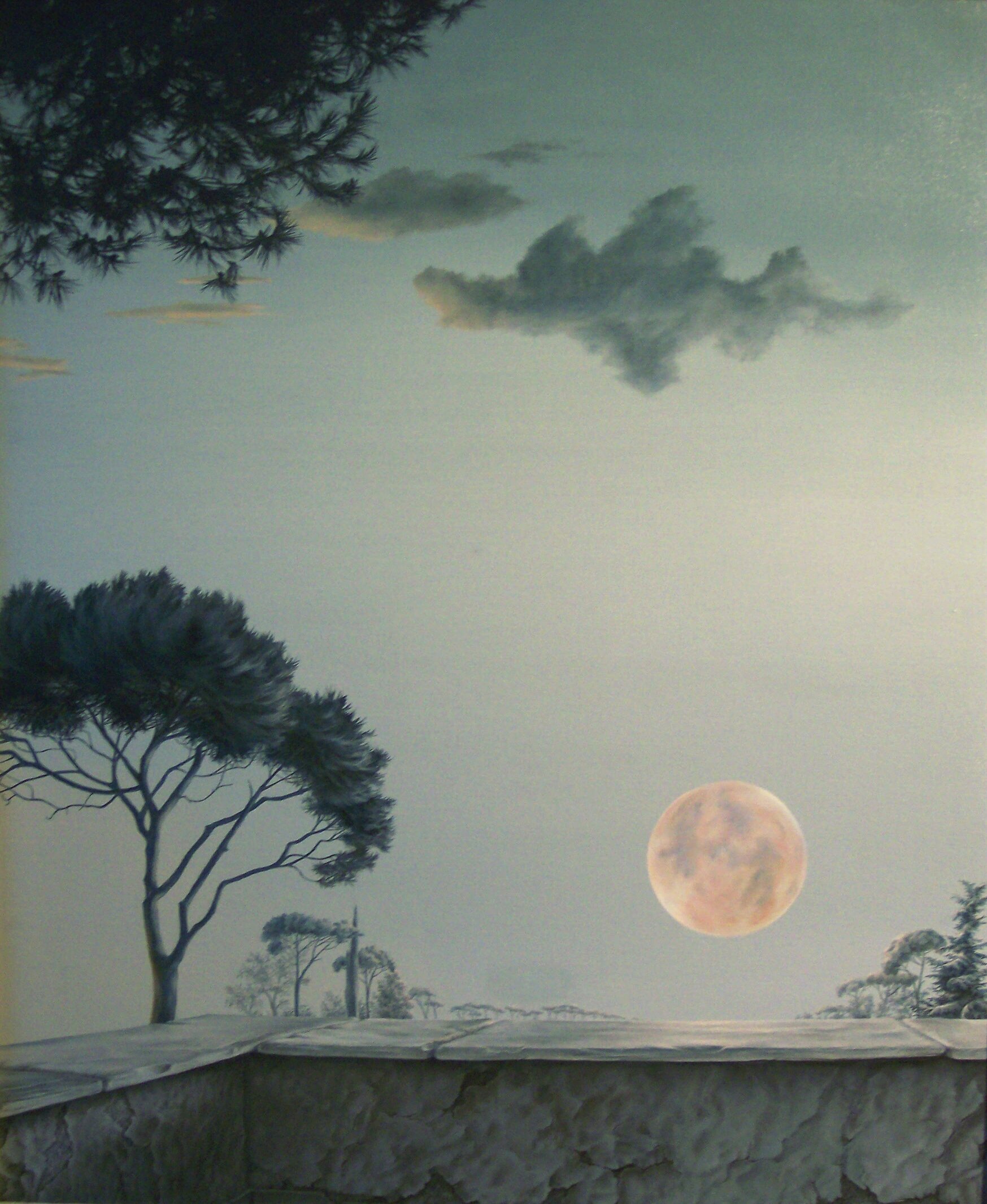
É tutto un assurdo combattimento tra le dimensioni spazio-temporali che ci appartengono ora, ma che un giorno non faranno più parte di noi, quella forte luce farà rinascere noi con lancinante dolore, forse lo stesso che proviamo ora, che ce lo impone la nostra dimensionalità tipicamente umana, un dolore non iniquo perché è da lì che diveniamo, nessun tipo di dolore è fine a sé stesso, ma tutto contribuisce a mutare. “… così dentro circostanze esauste di vita noi ostinati scaldiamo con piccole cose scaglie dorate di amori esauriti …”
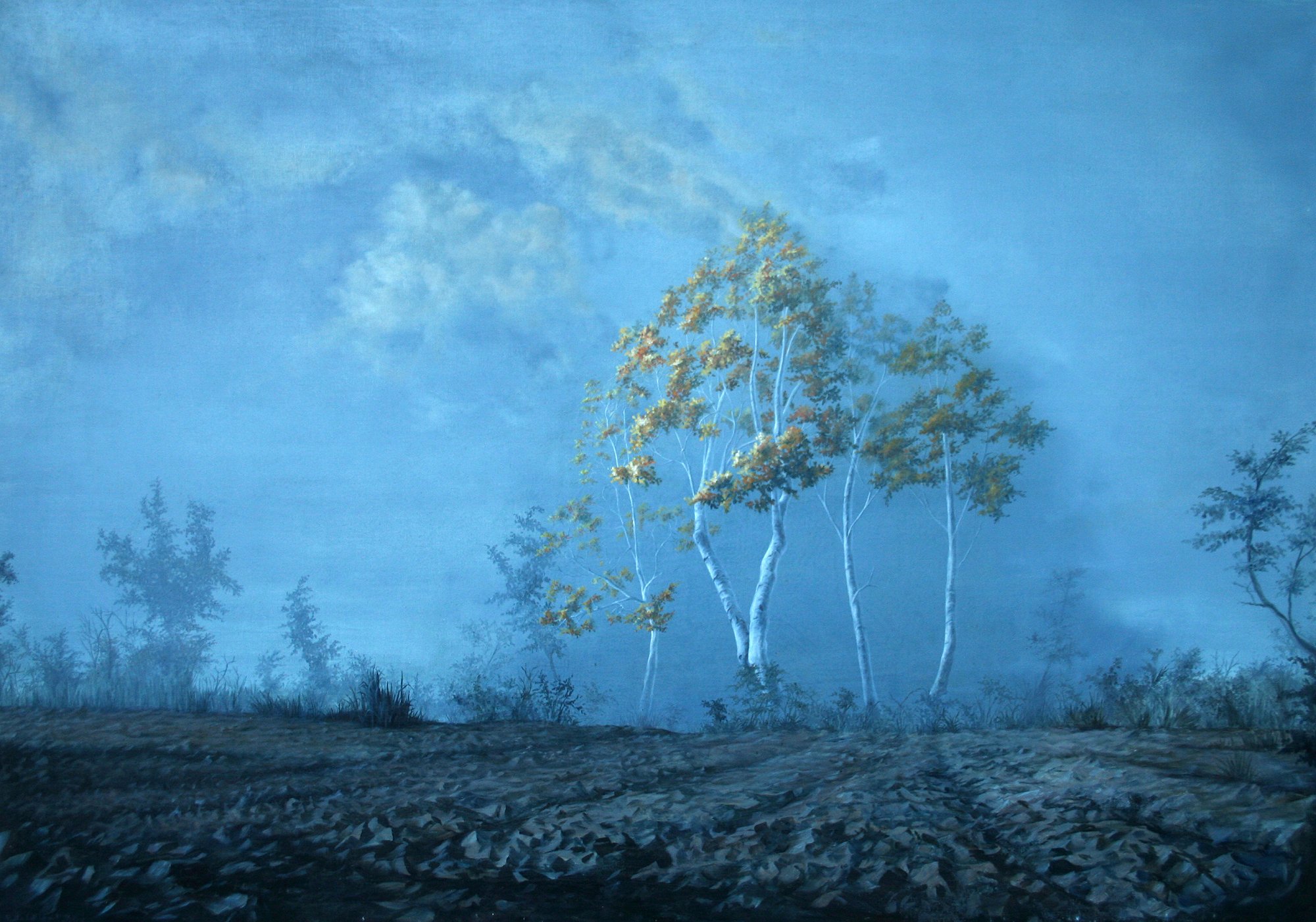
Il dolore del divenire, nella mutazione dovrebbe esentarci e dissuaderci dall’annegare ripetutamente in quelle circostanze esaurite nelle quali il ricordo ci fa sprofondare più e più volte, ma solo perché NOI glielo permettiamo. Così la poetica tanto suadente del Naturalismo Simbolico di Paola Colleoni dovrebbe regalarci dei romantici, a tratti tristi, cancelli aperti perché noi li possiamo attraversare ri-traendoci in una nuova dimensione, fuori dall’immaginario umano, non alla portata delle nostre menti limitate e suggestionate, terribilmente intrappolate nelle vicende del passato tanto da non farci vivere il presente, così tanto da scaricarci in uno status di schiavitù perenne spirituale e fisica, che ci intrappola quindi rendendoci così difficile prendere la strada della vera meta, quella che si trova oltre i cancelli, al di là del lontano orizzonte nebbioso, quella di cui non conosciamo il nome, quella che vorremmo ci venisse rivelata.


December 22, 2009
When observing Paola Colleoni’s works with dedication, we can’t help but get drawn into these suspended atmospheres, only found in dreams or poetry.

Imaginary rarefactions, metaphysical sunsets, dew, and thick fog frozen in soft, gentle, or vividly bright colors, when she speaks to us of green rounded mountains like sculptures from a distant time, echoing in our minds, enclosing a calm river whose beginning or end we cannot see, but where we can imagine ourselves as travelers still capable of being amazed by the sight of a marvelous, mysterious fjord and a special golden light reflecting on the waters and clouds.

Art critic Emanuela Mazzotti writes:
“What belongs to the experience of the real? These mountains, the color of the sky, the woods, the river…”.
I would say nothing can belong to the experience of the real, neither the artist nor art, because the moment the real passes through the human mind or the artist’s hand, whatever comes from the real no longer belongs to it. But if it should give the impression of it, it would only say that the person is frozen and the artist lacks inspiration and personality, if there is no transformation, even in the search for perfection, even slightly probing the ‘condition’ of the real or at least shaking up the contextualization of the real… well, I believe there would be no art, nor any artistic effort.
As Paola herself tells us in one of her poems written for the work “Itineraries – La Cisa”:
“… like roads, traverse emotions and thoughts while the destination of the journey disappears
And always reappears…”
So it is for those who create, or rather, rework, filtering with their own SELF what can be outside and inside the SELF.
But the dimension of the dream is suspended between what “is” and what is “becoming”.
A becoming inevitably crushed by the plausible impossibility of already being.
Paola reveals a certain light that follows omens and awakenings:
“… An awakening, omens. Then, there will be light…”

…And then perhaps that becoming through light, not long awaited, could have already shifted the dream dimension, becoming poetically real. But not True. “… My world sets inexorably, yet it seems still Suspended in time For a little while longer, it resists the overpowering light That comes from afar and is born with piercing pain”

It is all an absurd struggle between the space-time dimensions that belong to us now, but that one day will no longer be part of us, that strong light will rebirth us with piercing pain, perhaps the same we feel now, imposed on us by our typically human dimensionality, a pain not unjust because it is from there that we become, no type of pain is an end in itself, but everything contributes to change. “… so within exhausted circumstances of life we stubbornly warm with small things golden flakes of depleted loves…”

The pain of becoming, in transformation, should exempt us and dissuade us from drowning repeatedly in those exhausted circumstances where memory sinks us again and again, but only because WE allow it. Thus, the seductive poetics of Symbolic Naturalism by Paola Colleoni should gift us with romantic, at times melancholic, open gates that we can pass through, retreating into a new dimension, outside human imagination, beyond the reach of our limited and suggestible minds, terribly trapped in the events of the past so much that we do not live the present, so much that we are thrown into a state of perpetual spiritual and physical slavery, which traps us, thus making it so difficult to take the road to the true goal, the one that lies beyond the gates, beyond the distant misty horizon, the one whose name we do not know, the one we wish would be revealed to us.

Lodovico Gierut
Critico d’arte

da “Arte e grafologia 2”
di
Lodovico Gierut
Critico d’arte
Leggendo l’opera completa di Paola Colleoni, facendola cioè nostra, ci siamo ben presto convinti che le sue tante pagine possono consolidarsi in un vero e proprio libro, i cui capitoli si uniscono gli uni agli altri per definire la narrazione di un fatto, o la vista di un preciso paesaggio (anche dell’animo).
L’artista riesce sempre a concretare ogni dipinto volgendosi non solo verso un preciso tema, formulando una visione in cui l’atto è, da un lato, una vera e propria conquista di una realtà, dall’altro, una particolare produzione ‘storica’ della coscienza, considerando quest’ultima come un elemento per consegnare un valore-significato alla visibilità altrui.
Se osserviamo i suoi oli su tela, è lapalissiano notare che paiono quasi fuori del tempo, con la barca frustata dalle onde a simboleggiare una quotidianità esasperata dalla solitudine e dagli eventi, ma con la speranza di riuscire ad entrare in porto.
Lo prova il suo cielo, visto come regolatore dell’ordine cosmico, come elemento dell’eternità e della sacralità, ma non sono secondari quegli alberi che appaiono anche in “Lugano vento dall’est. Presentimento improvviso”, o in “Le Pont de Ponsonnas. Luce imprigionata”.
La luce dell’evoluzione, il ponte del passaggio dalla terra al cielo e dallo stato umano all’Oltre, come l’acqua delle origini, sono soltanto degli elementi su cui si basa il suo profondo ed impegnato dipingere.


from “Art and Graphology 2”
by
Lodovico Gierut
Art Critic
Reading the complete works of Paola Colleoni, making them our own, we quickly become convinced that her many pages can come together into a true book, with chapters interwoven to narrate an event or depict a specific landscape (also of the soul).
The artist consistently manages to concretize each painting by not only addressing a precise theme but also formulating a vision in which the act is, on one hand, a genuine conquest of reality, and on the other, a unique ‘historical’ production of consciousness, considering the latter as an element to convey a value-meaning to the visibility of others.
When we observe her oil paintings, it is obvious that they seem almost out of time, with the boat battered by the waves symbolizing a daily life exacerbated by solitude and events, yet with the hope of reaching a safe harbor.
This is demonstrated by her sky, seen as the regulator of cosmic order, an element of eternity and sacredness. Nor are those trees insignificant, which also appear in “Lugano, Wind from the East. Sudden Premonition” or in “Le Pont de Ponsonnas. Imprisoned Light.”
The light of evolution, the bridge representing the passage from earth to sky and from the human state to the Beyond, as well as the water of origins, are just some of the elements upon which her profound and committed painting is based.